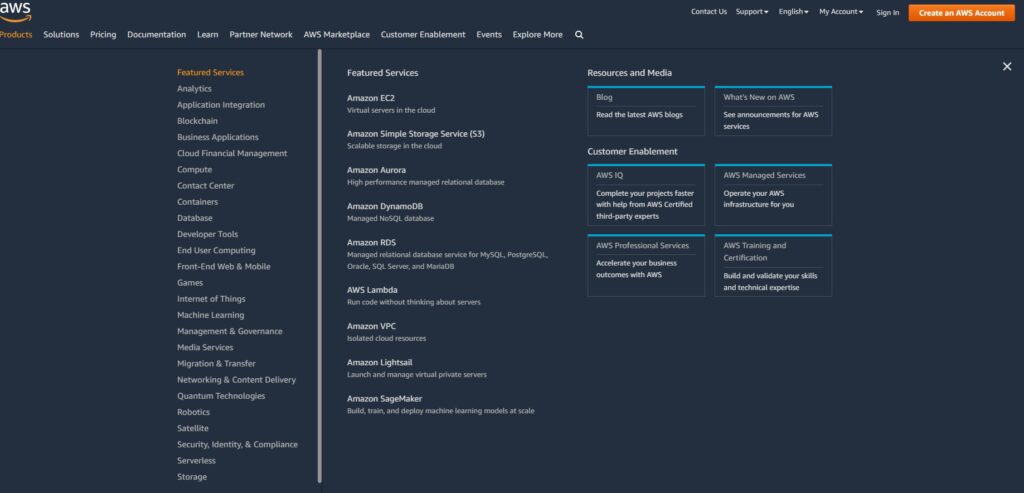Are you thinking about installing WordPress AWS ec2 on Amazon Web Services directly? Because Amazon Web Services (AWS) is the largest cloud hosting provider, it makes sense to give it a try.
Installing WP on AWS takes a little more effort than on other hosting platforms. Cloud hosting, on the other hand, is swiftly becoming the norm for many enterprises. This implies that understanding AWS can only help you and your website.
In this essay, we’ll discuss why you should use Amazon Web Services (AWS) for WordPress. We’ll go through the prices before showing you how to set up WP on AWS in three easy stages. Let’s get started!

Contents
How to create a WordPress AWS ec2 custom installation?
- The first step is to go to the Amazon Web Services website. You can register for free, but you will be required to input credit card information. Amazon will charge your credit card $1 to verify your identification.
- After your account has been verified, go to your AWS interface and select the ‘Services’ menu. To proceed, go to the compute section and select EC2.
- AWS’s EC2 cloud computing platform allows you to construct virtual machines and host web applications such as WordPress.
- Then, to launch and customize your instance settings, click the ‘Launch Instance’ option.
- You must first choose an Amazon Machine Image. These are software stacks that have been pre-configured and may be installed with a single click.
- Search for WP in the Amazon Web Services Marketplace and then select ‘WordPress by Bitnami.’
- You’ll now see a pricing window, and all you have to do now is click the proceed button.
- You’ll be asked to select an instance type on the next screen. Select the td. micro free tier and then click on the ‘Configure instance information’ button.
- Nothing needs to be changed on the following screen. Simply select ‘Next: Add Storage’ and then ‘Next: Add Tags from the drop-down menus.
- As a tag, we’ll now give this instance a name. Enter ‘Name’ as the key and ‘WordPress’ as the value in the Add Tag button.
- To continue, click the ‘Review and launch’ option.
- A summary of your EC2 Instance setup will now be displayed. To begin your instance, click the ‘Launch’ button.
- After that, you’ll be asked to choose a pair of keys. Select ‘Proceed without a key pair’ and then check the box to the right of it.
- Then, to save your settings and launch your EC2 instance, click the launch instances button.
- AWS will now display a notification of success. In the bottom right corner of the screen, click the ‘View Instances’ button.
- Your WP instance should now be up and running.
- You’ll need to find your WP site’s public IP address to test it. You may locate it next to your instance in the IPV4 Public IP column.
- To visit your website, copy this IP address and paste it into the address bar of a new browser tab. With the default theme, you’ll be able to see your WordPress site.
- To access your WordPress admin section, simply append /wp-admin/ to your site’s public IP address, as seen below: http://18.191.114.246/wp-admin
- The usual WordPress login page will now appear.
- To enter the admin area, you’ll need to know the username and password.
- You can get it by returning to your EC2 Console and selecting Instance Settings » Get System Log from the ‘Actions’ menu.
- This will open a log file containing a lot of text in a popup window. You’ll need to scroll to the bottom of the page to find a line that says ‘Setting Bitnami user password to’ and is surrounded by ## marks. You’ll also notice the app’s default username.
- You can now copy the username and password and paste them into your WordPress site’s login screen.
- You’ve completed the WordPress installation on Amazon Web Services. Your website, on the other hand, is still only accessible via the IP address.
- You’ll need to link your domain name to AWS’ DNS servers if you wish to point it to your AWS WordPress installation.

Check out our step-by-step guide on registering a domain name.
- You’re ready to add your domain name to your AWS instance once you’ve registered it.
- Amazon Web Services allows you to add a domain name to your WordPress site.
- Go to your EC2 instances dashboard and then click on ‘Elastic IPS’ under the ‘Network & Security section in the left column.
- To proceed, click the ‘Allocate New Address button.
- You’ll be asked how you intend to make use of the IP address. To proceed, simply click the Allocate button.
- For your WordPress EC2 instance, AWS will now generate a new elastic IP. Your IP address will be listed in a table. Simply choose the IP address row, then click the ‘Actions’ button and select ‘Associate Address.
- Select your WordPress instance from the drop-down menu and press the Associate button on the next screen.
- Your Elastic IP will now be mentioned in the table. Copy the IP address and paste it into Notepad or another text editor. It will be required in the following step.
- Then, at the top of the screen, go to the ‘Services’ menu and search for ‘Route53.’ This is the DNS administration service provided by Amazon Web Services, which allows you to route traffic to your EC2 instance.
- On the next screen, under the DNS control area, click the ‘Get Started Now’ button.
- This will take you to the section for hosted zones. To get started, click the ‘Create hosted zone’ option.
- The next step is to add your domain name to a hosted zone by clicking the create button.
- Click the ‘Create Record Set’ button after you’ve added your domain to a hosted zone. You must now type www in the ‘Name’ column. In the ‘Value’ field, paste the elastic IP you copied before, and then click the create button.
- Along with your domain name, the A record will now be added to your hosted zone. You must copy the lines under the NS field from the left column. These are the names of the nameservers you’ll need in the following step.
- Now you must go to your domain name registrar’s website and change the settings for your domain name. The screenshots following may differ depending on your provider, but the core procedures remain the same.
- In the DNS Nameservers section of your domain’s settings, paste the nameserver addresses you copied before.
- Remember to save your modifications. You may now go to the domain name you added and it will lead you to your Amazon Web Services-hosted WordPress site.

Managed WordPress Hosting with Amazon Web Services
- Setting up a custom WP installation on Amazon Web Services, as you may have noticed, is a pretty complex and complicated process.
- Amazon Web Services’ cloud computing infrastructure is available on a pay-as-you-go basis. This means that traffic spikes will drastically increase your hosting bill. Not to mention the fact that you will still be in charge of managing your services, which will be additional labor.
- Using a managed WordPress hosting service is a simpler method to run WordPress on Amazon Web Services without any effort.
- WP Engine is a good option. You don’t have to worry about traffic surges, server management, or WordPress maintenance because they run part of their hosting platform on AWS infrastructure.
- Pagely, a premium managed WordPress hosting provider, is another excellent option. They also use Amazon Web Services to administer their platform and provide a stress-free WordPress environment in which to expand your business

Conclusion
Amazon Web Services is a sophisticated cloud computing platform that allows anyone to pay as they go for access to Amazon’s superior infrastructure.
We hope that this post has shown you how to set up WordPress on Amazon Web Services!





